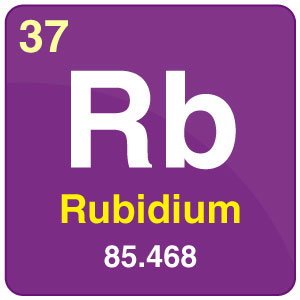Rubidium

| Symbol | Rb |
| Atomic Number | 37 |
| Atomic Mass | 85.4678 g.mol -1 |
| Discovered by | Gustav Kirchhoff and Robert Bunsen |

Chemical Properties of Rubidium
| Group | 1 | Melting point | 39.30°C, 102.74°F, 312.45 K |
| Period | 5 | Boiling point | 688°C, 1270°F, 961 K |
| Block | s | Density (g cm−3) | 1.53 |
| Atomic number | 37 | Relative atomic mass | 85.468 |
| State at 20°C | Solid | Key isotopes | 85Rb, 87Rb |
| Electron configuration | [Kr] 5s1 | CAS number | 7440-17-7 |
| ChemSpider ID | 4512975 | ChemSpider is a free chemical structure database | |
What is Rubidium?
- The element is a member of the alkali metal group 1 of the periodic table.
- The element has an atomic number of 37 and an atomic mass of 85.468 g cm3.
- The metal is a lithophile metallic element that does not form any minerals of its own.
Uses of Rubidium
- Rubidium finds its major application in speciality glasses which are utilized in fibre optics telecommunications systems and in night-vision devices.
- The carbonate of Rubidium (Rb2CO3) is used as an additive to these types of glass, where it reduces electrical conductivity and improves stability and durability.
- Rubidium-cesium-antimony coating is commonly applied to the photo-cathodes of photo-multiplier tubes, which are used in radiation detection devices, medical imaging equipment, and night-vision devices.
Properties of Rubidium
- Compared with potassium and sodium, rubidium is relatively rare, with a crustal abundance of just 78 mg kg-1 (Fyfe 1999).
- The Rb+ ion (ionic radius 152 pm) substitutes for K+ (138 pm) in mica such as muscovite and to a lesser extent in K-feldspar such as microcline and orthoclase, as well as rare minerals, such as lepidolite, carnallite, and pollucite, in which it replaces Cs.
Certain Facts About Rubidium
- Used in fireworks to give purple-red colour.
- The metal along with strontium is used to date rocks, minerals, and meteorites radioactively.
Related Videos


Comments